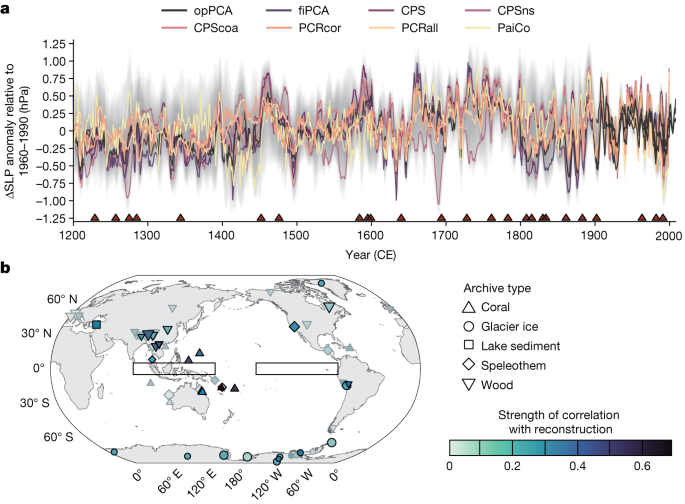2023-08-23 ワシントン大学セントルイス校
◆太平洋ウォーカー循環は、世界の降水パターンに影響を与え、気候モデルでは温暖化に対応して弱まると予測されていますが、最近の強化が人為的なエアロゾルによって引き起こされる可能性があることが示唆されています。
◆研究は、800年以上にわたる気象パターンのデータを使用して、太平洋ウォーカー循環の変化を調査しました。その結果、循環の挙動が変化しており、これが気象リスクを増大させる可能性があることが示されました。しかし、循環の強度にはまだ大きな変化は見られていないとされています。
<関連情報>
- https://source.wustl.edu/2023/08/study-atmospheric-circulation-weakens-following-volcanic-eruptions/
- https://www.nature.com/articles/s41586-023-06447-0
過去1000年にわたる太平洋ウォーカー循環の強制的変化 Forced changes in the Pacific Walker circulation over the past millennium
Georgina Falster,Bronwen Konecky,Sloan Coats & Samantha Stevenson
Nature Published:23 August 2023
DOI:https://doi.org/10.1038/s41586-023-06447-0

Abstract
The Pacific Walker circulation (PWC) has an outsized influence on weather and climate worldwide. Yet the PWC response to external forcings is unclear1,2, with empirical data and model simulations often disagreeing on the magnitude and sign of these responses3. Most climate models predict that the PWC will ultimately weaken in response to global warming4. However, the PWC strengthened from 1992 to 2011, suggesting a significant role for anthropogenic and/or volcanic aerosol forcing5, or internal variability. Here we use a new annually resolved, multi-method, palaeoproxy-derived PWC reconstruction ensemble (1200–2000) to show that the 1992–2011 PWC strengthening is anomalous but not unprecedented in the context of the past 800 years. The 1992–2011 PWC strengthening was unlikely to have been a consequence of volcanic forcing and may therefore have resulted from anthropogenic aerosol forcing or natural variability. We find no significant industrial-era (1850–2000) PWC trend, contrasting the PWC weakening simulated by most climate models3. However, an industrial-era shift to lower-frequency variability suggests a subtle anthropogenic influence. The reconstruction also suggests that volcanic eruptions trigger El Niño-like PWC weakening, similar to the response simulated by climate models.



